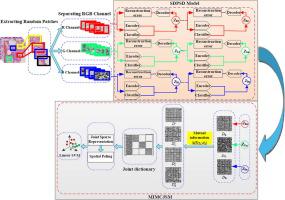Journal of Visual Communication and Image Representation ( IF 2.6 ) Pub Date : 2020-03-29 , DOI: 10.1016/j.jvcir.2020.102799 Xiao. Li , Hongzhong. Tang , Dongbo. Zhang , Ting. Liu , Lizhen. Mao , Tianyu. Chen

|
Histopathological image classification is a very challenging task because of the biological heterogeneities and rich geometrical structures. In this paper, we propose a novel histopathological image classification framework, which includes the discriminative feature learning and the mutual information-based multi-channel joint sparse representation. We first propose a stack-based discriminative prediction sparse decomposition (SDPSD) model by incorporating the class labels information to predict deep discriminant features automatically. Subsequently, a mutual information-based multi-channel joint sparse model (MIMCJSM) is presented to jointly encode the common component and particular components of the discriminative features. Especially, the main advantage of the MIMCJSM is the construction of a joint dictionary using a mutual information criterion, which contains a common sub-dictionary and three particular sub-dictionaries. Based on the joint dictionary, the MIMCJSM captures the relationship of multi-channel features, which can improve discriminative ability of joint sparse representation coefficients. Finally, the joint sparse representation coefficients of different levels can be aggregated using the spatial pyramid matching (SPM) model, and the linear support vector machine (SVM) is used as the classifier. Experimental results on ADL and BreaKHis datasets demonstrate that our proposed framework consistently performs better than popular existing classification frameworks. Additionally, it can show promising strong-robustness performance for histopathological image classification.
中文翻译:

通过区分特征学习和基于互信息的多通道联合稀疏表示进行组织病理学图像分类
由于生物学的异质性和丰富的几何结构,组织病理学图像分类是一项非常具有挑战性的任务。在本文中,我们提出了一种新颖的组织病理学图像分类框架,该框架包括判别特征学习和基于互信息的多通道联合稀疏表示。我们首先提出一个基于堆栈的判别预测稀疏分解(SDPSD)模型,方法是合并类标签信息以自动预测深度判别特征。随后,提出了一个基于互信息的多通道联合稀疏模型(MIMCJSM),以对编码特征的共同组成部分和特定组成部分进行联合编码。特别,MIMCJSM的主要优点是使用互信息标准构建联合词典,该词典包含一个共同的子词典和三个特定的子词典。MIMCJSM基于联合字典,捕获了多通道特征之间的关系,可以提高联合稀疏表示系数的判别能力。最后,可以使用空间金字塔匹配(SPM)模型汇总不同级别的联合稀疏表示系数,并将线性支持向量机(SVM)用作分类器。在ADL和BreaKHis数据集上的实验结果表明,我们提出的框架始终比流行的现有分类框架表现更好。另外,









































 京公网安备 11010802027423号
京公网安备 11010802027423号